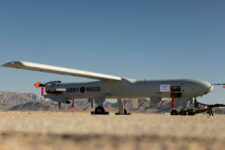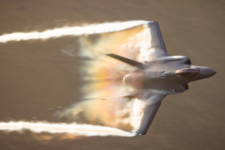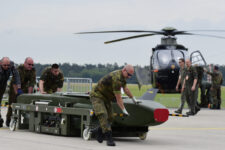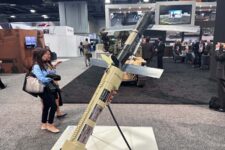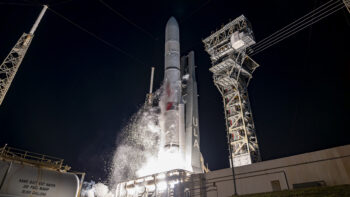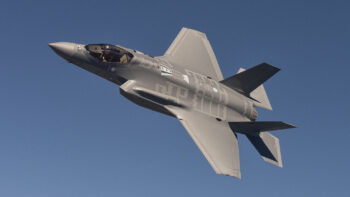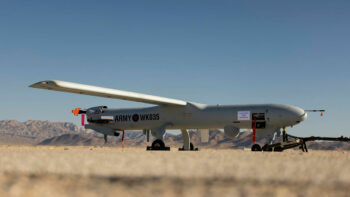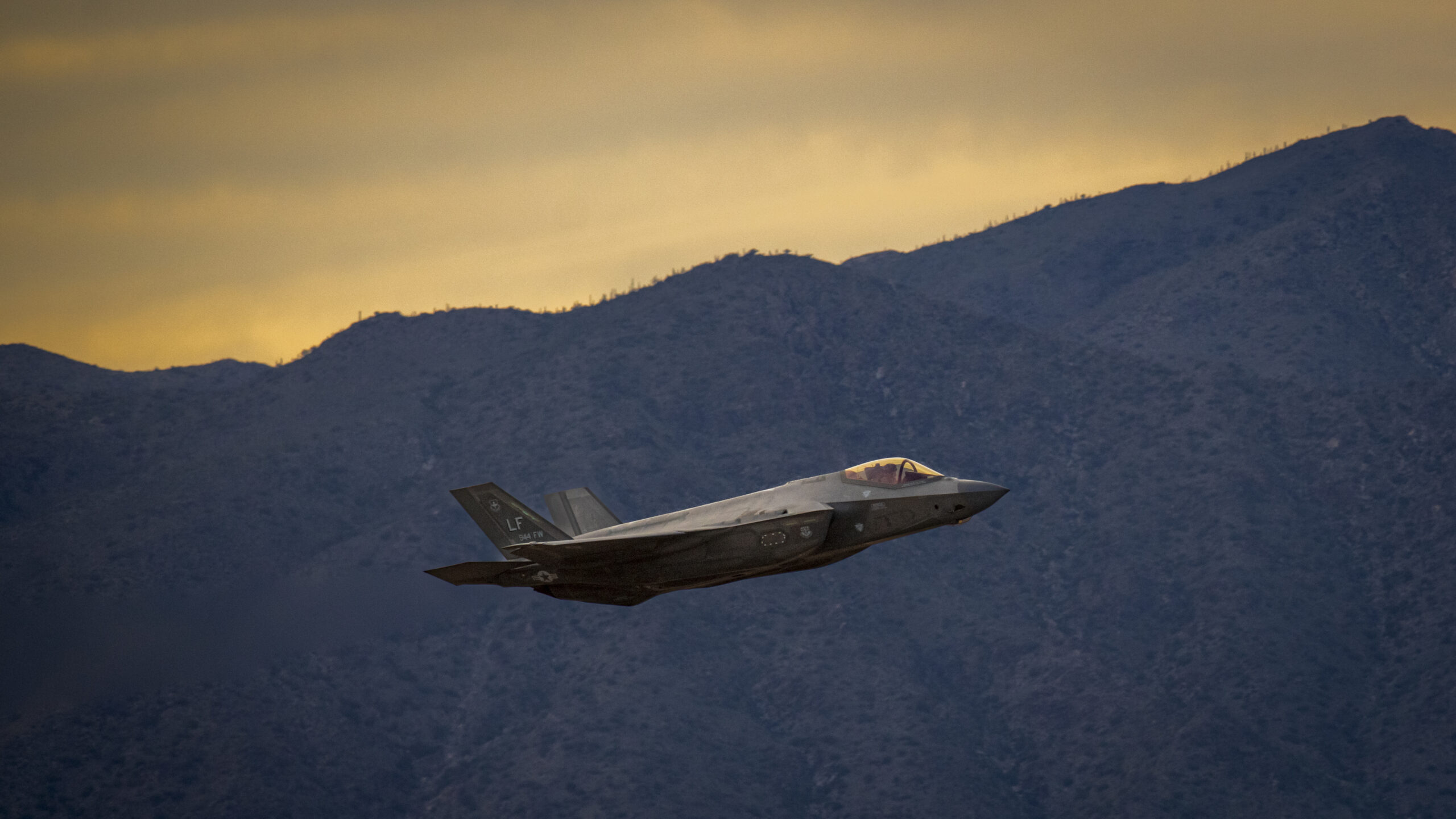
An F-35 Lightning II assigned to the 944th Fighter Wing, takes off from Luke Air Force Base, Arizona, Nov. 15, 2022. The F-35 is the U.S. Air Force’s latest fifth-generation fighter and provides next-generation stealth with enhanced situational awareness. (U.S. Air Force photo by Senior Airman Noah D. Coger)
PARIS AIR SHOW — Lockheed Martin is in talks with the F-35 Joint Program Office (JPO) to get an agreement for the next two production lots of the Joint Strike Fighter on contract by the end of the year, according to the head of Lockheed’s aeronautics division.
“We’re in initial discussions with the JPO for two lots, 18 and 19,” Greg Ulmer, Lockheed’s executive vice president of aeronautics, said in a Wednesday interview at the Paris Air Show. “I think we’re both targeting before end of year.”
Asked whether an option for a lot 20 would be included in the contract, Ulmer said the current focus is on the 18 and 19 lots. However, he added “the discussion is, potentially, 20 would be the first multi-year.” In December, the Pentagon awarded Lockheed a roughly $1 billion undefinitized contract action to begin ordering long-lead parts for lot 18 aircraft.
The lot quantities, Ulmer said, would support Lockheed’s goal of 156 annual F-35 deliveries that the company aims to hit beginning in 2025.
Negotiations over the lot 15-17 production agreement were hampered by pandemic and inflationary impacts, resulting in a “handshake” agreement in July 2022 that paved the way to a formal award in January 2023. This time, however, Ulmer reasoned things would be different.
“We were getting real-time updates associated with our cost position, and we had to inform the JPO of what that was. And then they had to do due diligence relative to receipt of that data,” he said. “We went through that negotiation, 15-17, with COVID, with inflation, and the prices that we negotiated are under the rate of inflation.”
Although Ulmer said challenges related to COVID have largely passed, he stated that inflationary pressures remain.
“You’re gonna see us inform ourselves relative to what inflation has done to our supply base, and that’ll inform that negotiation,” he said.
Engine Spat Not Likely A Short-Term Risk: Analyst
Ulmer’s comments on the lot negotiations followed his advocacy for an adaptive engine competition to field a new powerplant for the Joint Strike Fighter, a position that led to a swift rebuke from Pratt & Whitney and opened up an unprecedented rift between the airframe and engine manufacturers.
Richard Aboulafia, an aerospace analyst with AeroDynamic Advisory, said that high-profile spat “adds risk, but more in the medium and long run. For the next lot negotiations I doubt much will change.” (Contracts for the airframe and engine are also awarded separately, since the engines are government-furnished equipment.)
Future F-35 deliveries will further include upgraded fighters as the program fields Tech Refresh-3 (TR-3) hardware and software that will provide the computing backbone to enable a new suite of capabilities known as Block 4. Jets equipped with TR-3 are currently in production, but as first reported by Breaking Defense, the Pentagon will not accept those fighters until software qualification and flight testing wraps up.
Ulmer reiterated the company’s position to finish off TR-3 testing and kickstart upgraded aircraft deliveries before the end of the calendar year, adding that some 50 jets — roughly a third of the contractor’s planned deliveries for 2023, according to a report in Defense News — equipped with the updated hardware are in the current year’s delivery plan. But, he contrasted those jets with ones delayed by a recent engine issue that resulted in a partial grounding and halted acceptances, explaining that the TR-3 has already been deemed flightworthy, and all that’s needed to push upgraded fighters out the door is a final software approval.
“I’ll just have to squirt in the final software update and probably do kind of a flight around the flagpole, so to speak. And then we’ll deliver that airplane,” he said.

F-35 Lightning II aircraft from RAAF Base Williamtown fly of the coast of Newcastle on Nov. 23, 2020. (Australian Air Force)
A New Way to Manage Sustainment, Track Parts
A production agreement is not the only high-profile contract that the F-35 program is angling to nail down this year. Officials are also seeking to move toward a five-year, performance-based logistics contract, which lawmakers have mandated can only move forward if the agreement either decreases cost or increases readiness.
“I have a belief that performance-based logistics, where you’re held accountable to an outcome, drives performance,” said Ulmer.
As part of those negotiations, Pentagon officials have made clear that they’d seek more technical data from Lockheed to facilitate government-led maintenance, otherwise known as organic sustainment. Asked about how that desire is influencing negotiations, Ulmer replied that the Pentagon has “all of the data for the sustainment of the fleet. Now, they want additional data over and above and beyond that.
“The construct of the F-35, in the beginning, you would take an assembly off the airplane… And we provided the information to sustain that as a subsystem. Now they want to break that down into subcomponent levels,” he continued. “And so it’s really element-by-element working with those suppliers. And when you say Lockheed Martin, it’s not my data, much of the data is our supply base data… I don’t own the [intellectual property] for that. It could be a Honeywell, it could be Collins, it could be GKN, they own the data. And it’s really their negotiation through me to the government.”
In comments with reporters recently, Air Force Secretary Frank Kendall slammed the maintenance philosophy that governed the F-35 program from the outset, a framework called “Total System Performance” that the service’s top civilian described as where a winning contractor would manage “the whole lifecycle of the program.”
Those frustrations over the sustainment approach, Kendall said, have informed the structure of the service’s Next Generation Air Dominance program.
“They want to do business differently,” said Ulmer. “I will tell you, there are programs in place today, especially [ones that are] classified, where that’s already happened. And we’re supporting our customer straight across the table as they desire.”
Following a Government Accountability Office report that found over $85 million in spare parts for the Joint Strike Fighter are unaccounted for — a number the watchdog warned could be much higher — Ulmer insisted the aerospace giant is compliant with current requirements.
“We’re negotiating with the government today on how to redefine that so that we have more traceability to the parts,” he said, adding that per the program’s contract, “we are compliant to our requirement in managing those parts.
“They want to have more insight, more granularity,” he said. “So we’re gonna be working with the JPO to understand what that contractual requirement is, and we’ll put that in place to manage those parts.”






